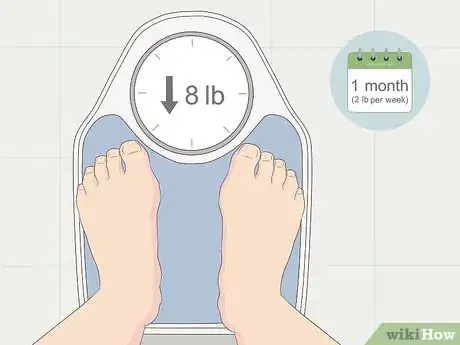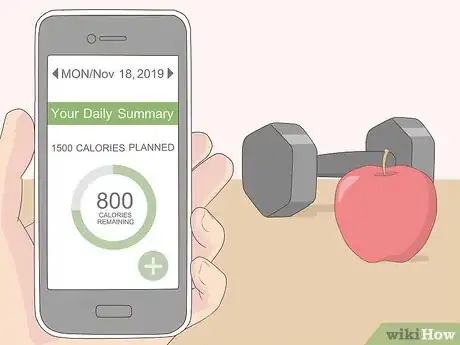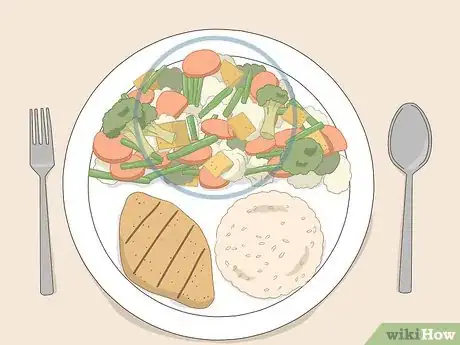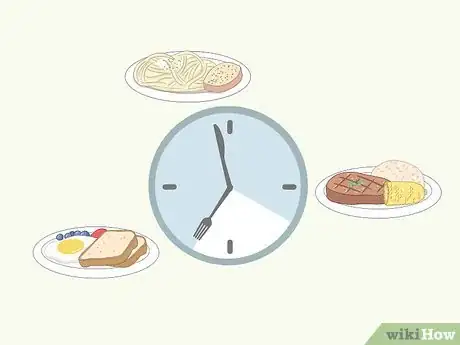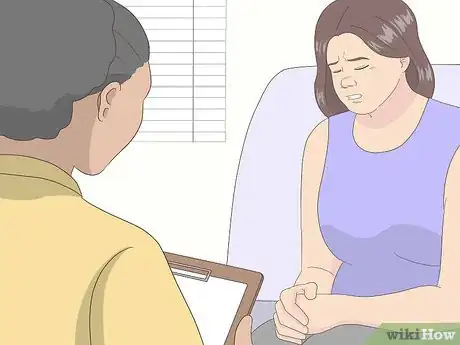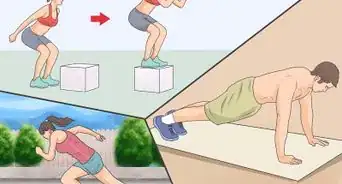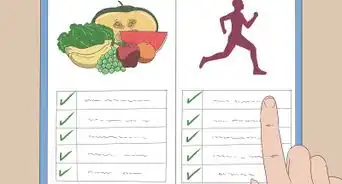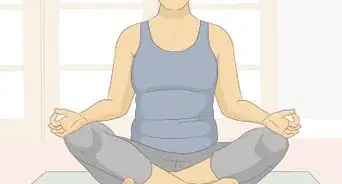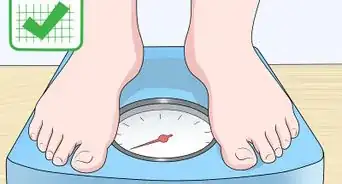This article was co-authored by Laura Flinn. Laura Flinn is a National Academy of Sports Medicine (NASM) Certified Personal Trainer, USA Olympic Weightlifting Sports Performance Coach and Certified Fitness Nutritionist, with an additional qualification as a TRX Suspension Trainer. Laura runs her own personal training program based in the San Francisco Bay Area and specializes in topics such as weight loss, muscle growth, cardiovascular training, and strength training.
There are 10 references cited in this article, which can be found at the bottom of the page.
wikiHow marks an article as reader-approved once it receives enough positive feedback. This article received 26 testimonials and 81% of readers who voted found it helpful, earning it our reader-approved status.
This article has been viewed 2,110,592 times.
To lose 50 lb (23 kg) in 2 months, you’d need to lose an average of 5 lb (2.3 kg) per week, which requires burning 2,500 more calories than you consume in a day. A healthy rate of weight loss is considered to be between 1–2 lb (0.45–0.91 kg) per week, which requires burning 500 to 1,000 calories more than you eat in a day.[1] This may be a slower pace than you’d hoped for, but keep in mind that slow weight loss is more effective than fast weight loss at reducing body fat, waist circumference, and hip circumference. By losing weight rapidly, you’re more likely to lose water than anything else and the weight you lose will likely come right back on.[2] Focus on developing a healthy weight loss plan for yourself, exercising more, and using other proven strategies to reach your ultimate weight loss goal.
Steps
Adjusting Your Plan and Eating Habits
-
1Set a realistic weight loss goal for yourself. It’s great to identify how much weight you want or need to lose over the long term, but short-term goals are important, too. Try to focus on how much you want to lose in 1 month and what you need to do to achieve that. Creating sub-goals to get you to your bigger goals will help to ensure that you stay on track.[3]
- For example, you might start by setting a 1 month weight loss goal of 8 pounds, which would require losing about 2 lb (0.91 kg) per week. This means that you’ll need to burn an extra 1,000 calories per day to achieve this goal, which you can do by cutting calories from your diet and exercising regularly.
-
2Identify your caloric needs and count calories to lose weight. Counting calories is an effective way to ensure that you’re reducing your food intake enough to lose weight. Your doctor can help you to identify a healthy calorie goal or you can calculate it yourself. Aim to cut between 500 and 1,000 calories from your diet per day with a combination of diet and exercise. Record everything you eat and drink using a food diary or calorie tracking app.[4]
- For women, a healthy amount is usually between 1,200 and 1,500 calories per day, while it’s usually around 1,500 to 1,800 calories per day for men.
Tip: Small changes can add up to big cuts in your caloric intake. For example, if you drink 16 fl oz (470 mL) of sugary soda or juice per day, switching to water will save 200 to 300 calories!
Advertisement -
3Fill up on nutrient-rich foods that are lower in calories. Fruits and vegetables will fill you up while adding fewer calories than other foods, such as bread, chips, and candy. Eat 1 to 2 servings of fruits or vegetables with every meal to keep yourself satisfied for fewer calories. Some great options include:[5]
- Salads made with fresh romaine lettuce, spring mix, or spinach and tomatoes and cucumbers.
- Steamed veggies like broccoli, cauliflower, carrots, green beans, and summer squash.
- Fresh cut melon, berries, apples, and pears.
-
4Look into intermittent fasting. Intermittent fasting is a way of eating where you consume all of your meals within an 8 or 10 hour window during the most active part of your day. For many people, this is between the hours of 7:00 am and 5:00 pm. However, you can designate a time frame that works for you. Just make sure to keep the same time frame each day so that you’ll have 14 to 16 hours between your last meal of one day and your first meal of the next day.[6]
- For example, you could eat breakfast at 7:00 am, lunch at 11:00 am, and dinner at 3:00 pm if you want to maintain an 8 hour eating window with a 16 hour fast.
- Or, you could eat breakfast at 9:00 am, lunch at 1:00pm, and dinner at 5:00 pm to maintain a 10 hours window with a 14 hour fast.
-
5Try following a low-carb or low-fat diet. Both of these eating strategies may help you to lose weight because they will restrict your calories through your available food choices. Therefore, it’s more important to choose a diet that you can stick with over the long term. If you like low-carb foods, such as eggs, bacon, cheese, and non-starchy veggies, then a low-carb diet may work well for you. However, if you can’t live without fruit, bread, pasta, and rice, then a low-fat diet may be a better choice.
- Remember, what’s most important is that you cut calories and create a deficit. You won’t lose weight if you’re not reducing your overall caloric intake.
-
6Drink more water than other beverages. Water has zero calories and it provides your body with the hydration it needs to function properly. You don’t need to drink anything else. Drink mostly water every day to reduce your overall caloric intake.[7]
- Avoid sugary soda, alcoholic drinks, and anything else that’s high in calories.
- Try adding a lemon or lime wedge to your water to flavor it. Or, you could toss in a few fresh berries or a cucumber slice for something even more exotic.
-
7Practice mindful eating strategies to slow yourself down. Eating mindfully is a way to become more aware of your body and the experience of eating so that you will eat less as a result. Some strategies you might try include:[8]
- Turning off the TV or computer, or putting away your phone while you eat.
- Eating with your non-dominant hand or using chopsticks.
- Focusing on other aspects of your food to help you slow down. Inhale the scent, notice how it looks on your plate, and chew slowly to savor the flavors and texture of the food in your mouth.
Exercising to Lose Weight
-
1Exercise for at least 150 minutes per week. This is the minimum recommended amount of exercise for maintaining good health, but the more exercise you get the better. Try to work in at least 30 minutes of exercise on most days of the week. Do something that you enjoy so that it’ll be easier for you to stick with it.[9]
- For example, you could take a walk on your lunch break or after dinner, go to an aerobics or spin class, or simply dance around your living room to your favorite music.
Tip: If you can’t fit in a full 30 minute workout all at once, split it up into shorter sessions, such as two 15-minute sessions or three 10-minute sessions.
-
2Work in more physical activity throughout the day. Doing a little extra whenever you get the chance can help you to burn more calories overall, and this will increase your weight loss results. Some things you can do to work more activity into your day include:[10]
- Parking further away from the entrances, such as at your place of work or at the grocery store
- Taking the stairs instead of the elevator
- Walking or biking to school or work
- Getting up and walking around or doing squats during a commercial break when you’re watching TV
-
3Try high-intensity interval training to burn more calories. High-intensity interval training, also known as HIIT, is when you exercise at a moderate pace, do a burst of high-intensity exercise, and then repeat this cycle in regular intervals. You can do HIIT with just about any form of exercise, such as walking, running, biking, swimming, or even dancing.[11]
- For example, you could walk at a moderate pace for 4 minutes, then walk at a brisk pace for 4 minutes, and then go back to the moderate pace for another 4 minutes. Keep repeating these intervals until you have completed 30 minutes of exercise.
- If you’re biking, try riding on a flat surface and then do a hill, then go back to a flat surface, then do another hill. Continue this for 30 minutes.
-
4Incorporate strength training to increase your resting metabolic rate. Building muscle increases your resting metabolic rate, which means you’ll burn more calories even when you’re asleep. You can use resistance bands, dumbbells, strength-training machines, or bodyweight exercises to build strength. Aim for two 30 to 45 minutes strength training sessions per week.[12]
- Make sure that you work each of your major muscle groups during the strength training sessions. These include your arms, legs, back, buttocks, abdomen, and chest.
Seeking Help to Lose Weight
-
1Look into therapy to change your eating habits. If you’re in the habit of eating whenever you feel stressed, sad, lonely, or tired, working with a therapist might be helpful for changing your behavior. A licensed mental health professional can help you to develop new tools for dealing with negative emotions instead of reaching for food as a distraction.[13]
- For example, if you often eat candy and other junk foods when you’re feeling stressed, a therapist could help you learn to use relaxation techniques, such as deep breathing or progressive muscle relaxation instead.
-
2Join a support group to get help from other people. Surrounding yourself with like-minded people can help you to stay motivated and avoid letting setbacks derail your progress. Try joining a weight loss support forum online or look for a weight loss support group in your area.[14]
- Some paid weight loss programs provide access to support groups, but there are also free support groups you can join, such as Take Off Pounds Sensibly (TOPS) or Overeaters Anonymous (OA).
Tip: If you’re having trouble finding a support group, ask your doctor or therapist if they know of any local weight loss support groups you can join.
-
3Talk to your doctor about weight loss medications. Several medications have been shown to be effective for improving weight loss results.[15] This might be an option for you if you have a body mass index (BMI) of 30 or higher or if your BMI is over 27 and you have weight-related health problems, such as diabetes or high blood pressure. Discuss your options with your doctor as well as the potential risks of the medications. Some commonly prescribed weight loss medications include:[16]
- Orlistat
- Lorcaserin
- Phentermine and topiramate
- Buproprion and naltrexone
- Liraglutide
-
4Find out if you’re a good candidate for bariatric surgery. While bariatric surgery is often a last resort for people who have tried for years to lose weight, it is very effective. This surgery involves reducing the size of your stomach so that you are physically incapable of overeating. If you’ve tried all of your other options and nothing seems to help, talk with your doctor to see if this might be an option for you.[17]
- Keep in mind that bariatric surgery carries risks just like any other surgery. Discuss these carefully with your doctor before you decide to go through with it.
Expert Q&A
Did you know you can get expert answers for this article?
Unlock expert answers by supporting wikiHow
-
QuestionHow much weight can I realistically lose in 2 months?
 Laura FlinnLaura Flinn is a National Academy of Sports Medicine (NASM) Certified Personal Trainer, USA Olympic Weightlifting Sports Performance Coach and Certified Fitness Nutritionist, with an additional qualification as a TRX Suspension Trainer. Laura runs her own personal training program based in the San Francisco Bay Area and specializes in topics such as weight loss, muscle growth, cardiovascular training, and strength training.
Laura FlinnLaura Flinn is a National Academy of Sports Medicine (NASM) Certified Personal Trainer, USA Olympic Weightlifting Sports Performance Coach and Certified Fitness Nutritionist, with an additional qualification as a TRX Suspension Trainer. Laura runs her own personal training program based in the San Francisco Bay Area and specializes in topics such as weight loss, muscle growth, cardiovascular training, and strength training.
NASM Certified Personal Trainer When I work with my clients on their weight loss goals, I advise them to aim to lose 1-2 pounds a week, which is often a reasonable and doable goal. However, how much weight they can realistically lose in 2 months depends on the individual. For example, if you have 50 pounds to lose, you'll lose weight faster than someone who only needs to lose a few pounds.
When I work with my clients on their weight loss goals, I advise them to aim to lose 1-2 pounds a week, which is often a reasonable and doable goal. However, how much weight they can realistically lose in 2 months depends on the individual. For example, if you have 50 pounds to lose, you'll lose weight faster than someone who only needs to lose a few pounds.
Warnings
- Avoid over-the-counter supplements and weight loss pills. Most of these are ineffective and only a few have shown a possible modest benefit. However, there is no diet pill or supplement that will help you to lose weight and keep it off.[19]⧼thumbs_response⧽
References
- ↑ https://www.mayoclinic.org/healthy-lifestyle/weight-loss/in-depth/weight-loss/art-20047752
- ↑ https://www.ncbi.nlm.nih.gov/pmc/articles/PMC5702468/
- ↑ https://www.mayoclinic.org/healthy-lifestyle/weight-loss/in-depth/weight-loss/art-20047752
- ↑ https://www.mayoclinic.org/diseases-conditions/obesity/diagnosis-treatment/drc-20375749
- ↑ https://www.mayoclinic.org/diseases-conditions/obesity/diagnosis-treatment/drc-20375749
- ↑ https://www.health.harvard.edu/blog/intermittent-fasting-surprising-update-2018062914156
- ↑ https://www.helpguide.org/articles/diets/how-to-lose-weight-and-keep-it-off.htm
- ↑ https://www.helpguide.org/articles/diets/how-to-lose-weight-and-keep-it-off.htm
- ↑ https://www.mayoclinic.org/diseases-conditions/obesity/diagnosis-treatment/drc-20375749
- ↑ https://www.mayoclinic.org/diseases-conditions/obesity/diagnosis-treatment/drc-20375749
- ↑ https://www.ncbi.nlm.nih.gov/pmc/articles/PMC2991639/
- ↑ https://www.ncbi.nlm.nih.gov/pmc/articles/PMC2931407/
- ↑ https://www.mayoclinic.org/diseases-conditions/obesity/diagnosis-treatment/drc-20375749
- ↑ https://www.mayoclinic.org/diseases-conditions/obesity/diagnosis-treatment/drc-20375749
- ↑ https://www.ncbi.nlm.nih.gov/pubmed/25692921
- ↑ https://www.mayoclinic.org/diseases-conditions/obesity/diagnosis-treatment/drc-20375749
- ↑ https://www.mayoclinic.org/diseases-conditions/obesity/diagnosis-treatment/drc-20375749
- ↑ https://www.ncbi.nlm.nih.gov/pubmed/30335479
- ↑ https://ods.od.nih.gov/factsheets/WeightLoss-HealthProfessional/
About This Article
If you want to lose 50 pounds in 2 months naturally, try to cook your own food as often as you can so you can control how healthy and how big your meals are. You should also drink 8 glasses of water a day so you aren’t as hungry between meals. In addition, do some cardiovascular exercise 4-5 times a week to speed up your metabolism. If you want more accountability, consider joining a weight-loss group like Weight Watchers to keep yourself motivated. Keep reading to learn how to distract yourself from hunger.
